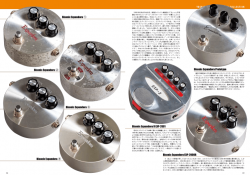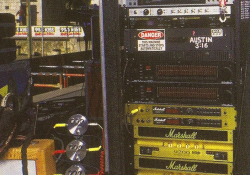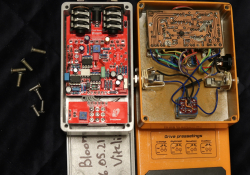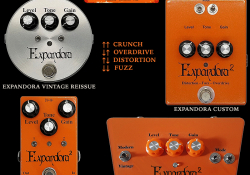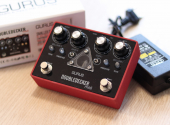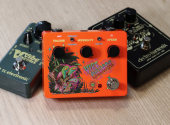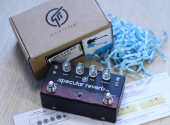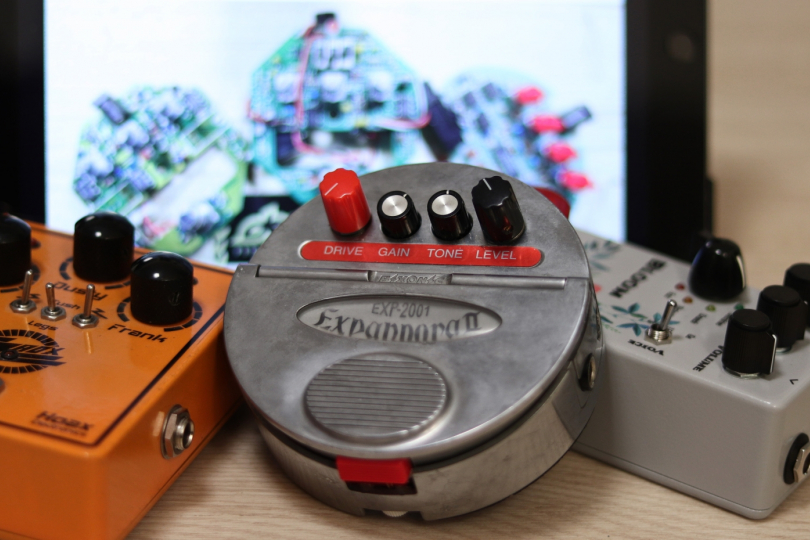
Pedalboard Gems #13: Bixonic Expandora
The (un)lucky thirteen in our series was quite fittingly drawn by my favourite obscure artefact, which despite very decent marketing support, uniqueness and indisputable qualities, has been erased from history instead of enjoying the limelight. However, it never ceases to nag at the minds of various manufacturers as they regularly try to bring it back to the scene in different variations.
I love the sound of ZZ Top’s album Rhythmeen, so of course, the mythical Bixonic Expandora effect couldn’t escape my attention. In fact, Reverend Willy G (aka Billy Gibbons) spread rumours that this gear was the main ingredient in the magically mega-thick yet still audible “rhythmeen” sound. Even in the deliberately shocking configuration of six (!) identical stompboxes plugged behind each other that Mr G ostentatiously displayed on stage. Or he would attach the “round can” directly to his guitar—we can catch a sight of it in the clip for the From Dusk Till Dawn film.
However, I’ve picked up some knowledge since then, so I’d venture a guess that Billy had a lot of fun with this prank, in the end, supported by the avant-garde art sculpture Lap Dog Of Distortion. In describing how he achieves his sound, he’s been successfully and entertainingly equivocating (or deliberately misleading everybody) throughout his entire career, always giving only hints or speaking in riddles, never providing a complete and concrete guide. But that doesn’t change the fact that thanks to this world star, this uncommonly round stompbox has been given awesome media attention.
The Bixonic Expandora is a unique Japanese hockey puck-shaped multi-distortion gadget from the mid-1990s. Besides ZZ Top, its users included surprising names like Megadeth, Joe Satriani, Bootsy Collins and St. Vincent. The three modes (plus one “secret one”) cover a sonic palette ranging from the light boost to wild fuzz and everything in between. It’s adaptable to a multitude of styles, pickups, guitars and even basses.
When googling, you’ll often come across comments from “forum experts” saying that it’s just a regular RAT distortion—with which it really shares many similarities in wiring. But the Expandora’s clever design pushes it to new dimensions, not only with the gain range but more importantly with the special expander circuitry that delivers exceptional response to the pick attack and a creamy tone rich in a multitude of harmonics that literally comes to life under your hands.
There were several versions over time, which you can still come across in international second-hand shops:
- EXP-2000 with internal dip switches, called the original from 1995
- EXP-2001 with four knobs and a light-responsive logo from 2001
- EXP-2000R external dip switches with added switch for guitar and bass, reissue from 2004
I’ve never seen the absolutely rare version with the so-called script logo there. I have also been looking for a typical sample, but YouTube didn’t help me much in this case, as most of them don’t meet today’s sound standards. So I’ll make do with the most recent reissue from an American company that bought the license and has been offering several versions of this legend since last year under the Expandora 2.
As you can hear, Expandora’s scope is really interestingly wide. But when I got a hankering for it, it wasn’t readily available in my country, so I had to go for DIY. Of course, even that wasn’t as easy then as it is now—when you can order not only the circuit board (pcb) but also the kit, including all the parts. I deliberately dug a receipt for purchasing a Sharp PC419 optocoupler out of my files. This tiny component used in calculators is an essential part of the circuit, and I had to order it from the USA for 4 dollars + shipping because I couldn’t find it anywhere in Europe 12 years ago.
So we set to work with determination, and I still laugh at the first enthusiastic reaction of Mr Hoax (who was putting together my dream ZZ Box) after the “secret” mode was put into operation: “Billy Corgan would have his finger cut off for a box like that!” I think that not only Smashing Pumpkins would appreciate this Forbidden mode. It’s a fun sizzling wild fuzz—but still controllable and usable for noise experimentation thanks to the expander circuit. Like in this sample when I incorporated it into a crazy mushroom-stoner project.
The first three modes, named Crunch, Drive and Distortion, then work with the more classic manifestation of dynamic overdrive. In the ZZ Box, we combined the most classic EXP-2000 with the slightly sharper and more saturated EXP-2001 that didn’t win too many fans though. The company's business model was to cut costs in an almost nonsensical way, and, for example, they didn’t even use pots but trimmers controlled by plastic mini-knob axes. This might have been a suitable solution for a children’s toy, but certainly not for a real-world effect.
It is possible to replace the first trimmer controlling the three modes with a real pot and, with a slight modification, get the fourth fuzz, which was not available in the original version. In the next version, we replaced the two not very practical mini switches with a rotary one, which was much more operative.
This idea has also been developed in the latest clone from Ukrainian-Polish Drunk Beaver, and their Bloom adds signal LEDs for individual modes, a distortion mode switch and a guitar/bass switch. Inside there’s an even cuter tweak where you can adjust the brightness of the main LED, which can sometimes be an eye-sore—it's definitely a more elegant solution than taping a gaffer over.
Also coming soon is a mini version of the Decibelics Reverend from a Spanish manufacturer producing high-end and well-respected boutique clones. But these are still almost conspiratorial methods of getting effects from one-man companies. Is there a more common way?
Of course, there is. In fact, the mythical circuit has also appealed to the “mass boutique guy” Josh Scott, who offers the readily available JHS Kilt aka “the echo of songs expanded.” Currently in a V2 version, scaled down from the original V1, made as the first signature JHS pedal for guitarist StuG of Christian rock’s Delirious?.
Gradually I had the opportunity to compare various clones with the originals as well, and to my ear, they sound very similar in principle. Of course, I tried to plug in all those I had one after another, but unfortunately, it didn’t work for me as it did for Billy Gibbons. Could it be the difference in hands, maybe? :)
I still don’t get why the pedal is not as popular as it should be, but if you follow this road less travelled, you may stumble across an unusual treasure that may appeal to you as much as it did to me. Let’s Expand Together! :)
If you have found an error or typo in the article, please let us know by e-mail info@insounder.org.

